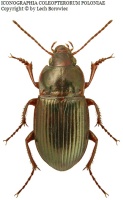
Русские, остановите эту войну! Спасите Свободную Украину!
Russians, stop this war! Save Free Ukraine!
Biodiversity Map
Taxa

Paracelia — subordinate taxa:
Taxon count: 1
-
Arthropodaphylum
Click to switch
to select orders
and filters > -
Hexapodasubphylum
Click to switch
to select orders
and filters > -
Insectaclass
Click to switch
to select orders
and filters > -
Coleopteraorder
Click to set
as the main taxon
and as a base
← of the left panel > -
Adephagasuborder
Click to set
as the main taxon
and as a base
← of the left panel > -
Carabidaefamily
Click to set
as the main taxon
and as a base
← of the left panel > -
Harpalinaesubfamily
Click to set
as the main taxon
and as a base
← of the left panel > -
Zabrinitribe
Click to set
as the main taxon
and as a base
← of the left panel > -
Amarinasubtribe
Click to set
as the main taxon
and as a base
← of the left panel > -
Amaragenus
Click to set
as the main taxon
and as a base
← of the left panel > -
Paraceliasubgenus
Click to set
as the main taxon
and as a base
← of the left panel > -
Amara quenselispecies
Click to set
as the main taxon
and as a base
← of the left panel >
PL
YES
name status: valid name
BioMap ID: 1004256
taxon code: 254
taxonomy checked: YES
Polish Red List: VU
Data on distribution in Poland

Statistics
- Records: 132
- Publications: 67
- Collections: 6
- Publication authors: 60
- Illustrations (iconography): 1
- Photos (specimen/observation): lacking
Taxon description
Szeroko rozmieszczony gatunek okołobiegunowy; w Ameryce Północnej sięga na południe wzdłuż gór do Nowego Meksyku, w faunie Europy określany jako borealno-alpejski. Znany w Europie od skrajnej północy do Pirenejów, Alp Południowych, Czarnogóry, Karpat Południowych i Bułgarii, notowany również z Kaukazu. Występuje w dwu formach: nominatywnej, właściwej dla gór i północnej części kontynentu, oraz formie nizinnej Amara (Celia) quenseli silvicola Zimm., zasiedlającej obszary wokół Bałtyku i północną część Europy Środkowej. Żyje na suchych, słabo ocienionych glebach piaszczystych, często ze znaczną domieszką żwiru i kamieni. Forma nizinna spotykana na wydmach nadmorskich, a wewnątrz lądu głównie na terenach morenowych i lotnych piaskach, warunki ekologiczne formy górskiej słabo poznane, notowany z dużych wysokości do 3000 m n.p.m. Forma górska w Polsce wykazywana była z Tatr oraz Beskidu Zachodniego i Sudetów Wschodnich, o występowaniu na dwu ostatnich obszarach wątpi A. Horion (1941).
Illustrations
... browse
 Amara
Amaraquenseli
silvicola
External data sources
- Ostatnie rekordy
-
1108347
 ×
× Carabidae: Amara quenseli silvicola, PL, Pobrzeże Bałtyku, Słowiński P.N., UTM XA35, 1982 (Kaczmarek 1985b)
Carabidae: Amara quenseli silvicola, PL, Pobrzeże Bałtyku, Słowiński P.N., UTM XA35, 1982 (Kaczmarek 1985b) -
1101185
 ×
× Carabidae: Amara quenseli silvicola, PL, Pojezierze Pomorskie, UTM XV63, 1994 (Stachowiak 1998b)
Carabidae: Amara quenseli silvicola, PL, Pojezierze Pomorskie, UTM XV63, 1994 (Stachowiak 1998b) -
1101184
 ×
× Carabidae: Amara quenseli silvicola, PL, Pojezierze Pomorskie, UTM XV63, 1994 (Stachowiak 1998b)
Carabidae: Amara quenseli silvicola, PL, Pojezierze Pomorskie, UTM XV63, 1994 (Stachowiak 1998b) -
997740
 ×
× Carabidae: Amara quenseli silvicola, Łomianki, 1915, coll. MiIZ PAN: Tenenbaum Sz.
Carabidae: Amara quenseli silvicola, Łomianki, 1915, coll. MiIZ PAN: Tenenbaum Sz. -
997739
 ×
× Carabidae: Amara quenseli silvicola, Łomianki, 1915, coll. MiIZ PAN: Tenenbaum Sz.
Carabidae: Amara quenseli silvicola, Łomianki, 1915, coll. MiIZ PAN: Tenenbaum Sz. -
997738
 ×
× Carabidae: Amara quenseli silvicola, Drewnica, 1920, coll. MiIZ PAN: Tenenbaum Sz.
Carabidae: Amara quenseli silvicola, Drewnica, 1920, coll. MiIZ PAN: Tenenbaum Sz. -
997736
 ×
× Carabidae: Amara quenseli silvicola, coll. MiIZ PAN: Tenenbaum Sz.
Carabidae: Amara quenseli silvicola, coll. MiIZ PAN: Tenenbaum Sz. -
714662
 ×
× Carabidae: Amara quenseli silvicola, DE, Hanover, coll. IOR
Carabidae: Amara quenseli silvicola, DE, Hanover, coll. IOR -
646862
 ⊡
⊡ Carabidae: Amara quenseli silvicola, PL, Pojezierze Pomorskie, Niedźwiady, UTM XV37 (Szyszko 1983e)
Carabidae: Amara quenseli silvicola, PL, Pojezierze Pomorskie, Niedźwiady, UTM XV37 (Szyszko 1983e) -
646371
 ⊡
⊡ Carabidae: Amara quenseli silvicola, PL, Nizina Wielkopolsko-Kujawska, Krzystkowice, UTM WT13 (Szyszko 1983e)
Carabidae: Amara quenseli silvicola, PL, Nizina Wielkopolsko-Kujawska, Krzystkowice, UTM WT13 (Szyszko 1983e) - ... more
- Powiązane publikacje
-
Schwerk A., Szyszko J. 2007a. Mittlere Individuen Biomasse (MIB) von epigäischen Laufkäfern (Coleoptera: Carabidae) als Indikator für Sukzessionsstadien. Angewandte Carabidologie, 8:69-72.
 Show records
Show records -
Maciejowski W. 2006. Interrelations between relief and distribution of the beetles from family Carabidae in the karst upland landscape. Ekológia, 25(Supl. 1):141-147.
 Show records
Show records -
Pawłowski J.S., Kubisz D., Mazur M. 2002. Coleoptera Chrząszcze. [In:] Głowaciński Z. (Ed.) Czerwona lista zwierząt ginących i zagrożonych w Polsce. Polska Akademia Nauk, Instytut Ochrony Przyrody, Kraków. pp. 88-110.
 Show records
Show records -
Skłodowski J. 2001a. The structure of carabid communities in some field forest ecotones. Baltic J. Coleopterol., 1(1-2):41-52.
 Show records
Show records -
Pawłowski J.S., Petryszak B., Kubisz D., Szwałko P. 2000. Chrząszcze (Coleoptera) Bieszczadów Zachodnich. Monogr. Bieszcz., 8:9-143.
 Show records
Show records - ... more





